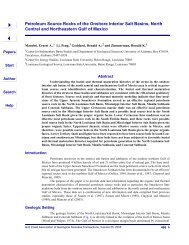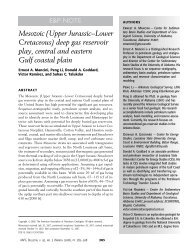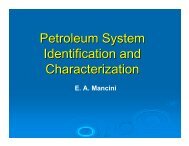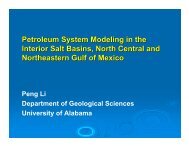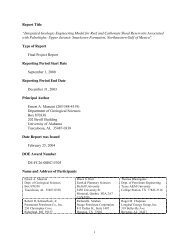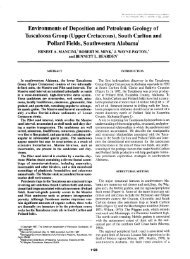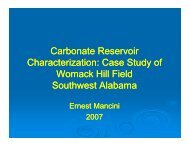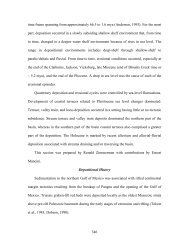Norphlet Formation (Upper Jurassic) - Berg - Hughes Center
Norphlet Formation (Upper Jurassic) - Berg - Hughes Center
Norphlet Formation (Upper Jurassic) - Berg - Hughes Center
Create successful ePaper yourself
Turn your PDF publications into a flip-book with our unique Google optimized e-Paper software.
Ernest A. Mancini et al 895^JS,800\EXPLANATIONSTRUCTURE CONTOUfi(CONTOUR INTERVAL 60 FT]I FIELD BOUNDARYNOPPHLETOiL WELLSMACKOVER GAS-CONDENSATE WELLDRV HOLESCALEFigure 15—Top of <strong>Norphlet</strong> structure map for Copeland oilfield, Washington County, Alabama. (Published with permissionof Amoco Production Company.)in the Florida panhandle (Figure 2). The <strong>Norphlet</strong> reservoirin Chavers Creek and Sizemore Creek fields is primarilywadi and dune sandstones. Average porosity isestimated at 22.1 %, and average permeability is estimatedat 47.4 md in Chavers Creek field (Inexco Oil Company,1984, personal communication). These new oil-field discoveriesby Inexco and <strong>Hughes</strong> Eastern indicate that additional<strong>Norphlet</strong> oil fields are probably present along thePoUard-Foshee and Gilbertown-West Bend fault systems.The <strong>Norphlet</strong> petroleum trap in Copeland oil field (Figure15), Washington County, is a salt anticline. The fieldwas discovered in 1974 with the Amoco Production CompanyW. M. Curlee 1 well. The Curlee well produced over95,0(X) bbl (1.5 X lO" m') of oil and 59mmcf (1.7 x 10**m') of natural gas between 1974 and 1979. Presently, no oilis being produced from the <strong>Norphlet</strong> at Copeland. The<strong>Norphlet</strong> reservoir in this field is probably dune and interdunesandstones of the Denkman. The reservoir has anaverage porosity of 18% and an average permeability of197 md.The Hatter's Pond field (Figure 2), Mobile County,which was discovered in 1974 with the Getty Oil CompanyPeter Klein 3-14 1 well, produces from both the Smackoverand the <strong>Norphlet</strong> <strong>Formation</strong>s. The petroleum trapinvolves salt movement along the west side of the Mobiletault system that has resulted in a faulted salt anticline.Through 1983, over 16.7 million bbl (2.7 x 10* m')of condensateand 65 bcf( 1.8 X lO'm') of natural gas have beenproduced with 13 wells currently producing from thisfield. The <strong>Norphlet</strong> reservoir in Hatter's Pond field is theDenkman. The porosity of the dune and marine sandstonesat Hatter's Pond field has been interpreted as secondary(Figure 9E) by Honda and McBride (1981). Theybelieve that this secondary porosity is a result of decementationof anhydrite or calcite and by grain dissolution.Porosity averages 10.4%, and permeability averages 0.5md in the Hatter's Pond field.The <strong>Norphlet</strong> petroleum trap in the Lower Mobile Bay-Mary Ann gas field (Figure 16), Mobile Bay, Alabama, is alow-relief, faulted salt anticline. Mobil Oil Explorationand Producing Southeast, Inc. (MOEPSI), discovered thisnatural gas field in 1979 with the State Lease 347 1 well. Todate, the sbc wells drilled to test the <strong>Norphlet</strong> in the fieldhave been successful gas wells. The four wells that weretested flowed at rates of 10.5 to 19.4 mmcf (3 to 5.5 x lO'm') of natural gas per day. The primary reservoir in theMobile Bay area is the Denkman dune sandstones. Porosityaverages 10.9% in this field and is principally developedas secondary as a result of decementation and graindissolution in the Mobile Bay area (Figure 9F). Permeabilityof these eolian sandstones averages 1.1 md. Reservesfor this field are estimated to be as much as 600 bcf (1.7 x10'" m^) of natural gas (Sumpter, 1981). The discoveries(Figure 2) by MOEPSI in open waters of the Gulf of Mexico(Mobile Area Block 823) and in the Mississippi Sound(Alabama Block 72), 4.5 mi (7.2 km) southwest and 11 mi(17.7 km) west of the Lower Mobile Bay-Mary Ann field,respectively, and by Exxon in open waters of the Gulf ofMexico (Mobile Area Block 867) and in Lower Mobile Bay(Alabama Block 63), 5.5 mi (8.8 km) southwest and lessthan 1 mi (1.6 km) north of the Lower Mobile Bay-MaryAnn field, respectively, indicate that the natural gasreserves for the offshore Alabama area may be several trillioncubic feet of natural gas (Petrie and Wright, 1984).The <strong>Norphlet</strong> marine sandstones in the Mobile Bay areahave minimal porosity because of the presence of a highpercentage of carbonate and/or quartz cement (Figure4D).An analog for the large offshore natural gas fields beingdiscovered in offshore Alabama would be the Viking gasfield of the North Sea, which has estimated in-placereserves of 3.6 tcf (1.0 x lO" m') of natural gas (Gage,1980). The Viking field produces natural gas from theLeman Sandstone <strong>Formation</strong> in the Lower Permian RotliegendesGroup. The petroleum trap involves normalfaults. The reservoir consists of dune and wadi sandstoneswith the wadi sandstones accounting for poor reservoirperformance in certain areas of the field. The petroleumsource rocks are probably the underlying Carboniferoussediments (Gage, 1980).Smackover algal carbonate mudstones were probablythe source for the <strong>Norphlet</strong> hydrocarbons. These mudstonesare locally rich in algal and amorphous kerogen(Mancini and Benson, 1980). Analyses of samples fromthe black shales associated with the <strong>Norphlet</strong> in EscambiaCounty have indicated these shales are essentially barren




